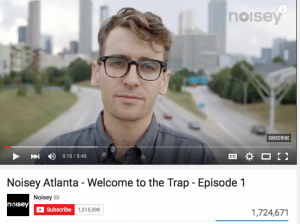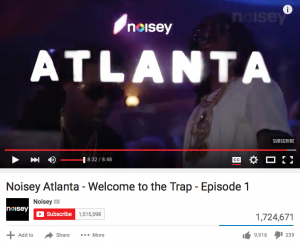When Noisey Atlanta Episode 1 is typed into the YouTube search bar, a gray screen with a frowning box prompts the viewer to “sign into your account to confirm age- some of the content in this video may be inappropriate for children under 18.” When I sign into my account confirming me to be age 18 or over, YouTube automatically redirects me to the Noisey Atlanta-Welcome to the Trap- Episode 1 page. All along the right hand side of the page, the following episodes in the Noisey Atlanta Series are displayed for choosing, along with some other Noisey series and other videos from similar modern publications such as Vice.com. After some buffering, the video plays and the mise-en-scène (a French term that means “placing on stage, in film meaning the arrangement of everything that appears in the framing – actors, lighting, décor, props, costume) is instantly set. Noisey journalist Thomas Morton stands superimposed in front of a highway connector with Downtown Atlanta slightly out of focus in the background. The video cuts away to an birds eye view of “Spaghetti Junction” ,the series of interconnected and overlapping interstates and highways Atlanta is known for, with a heavy trap beat playing in the background. Thomas Morton is shown walking into a house with yellow tinged plaster on the outside and iron bars covering the doors and the windows. A black man decorated with chains and a black baseball cap on his head is stirring a pot on an electric stove. White lettering in the bottom left hand corner of the video gives a name to the space Morton just entered- The Trap. The camera leaves the kitchen area occupied by Morton and the man cooking dope of the stove and pans out to reveal the front of the yellow tinged house, the theme song and title fade in, superimposed in front of the yellow house: “Noisey Atlanta” Appears. Morton speaks on the
history of Atlanta as a travel stop or major destination- connecting Atlanta’s abundance of highways, interstates, and airline stops to its prevalence in drug trafficking- all while cars pass behind and underneath him from his spot on a highway overpass. Trap music continues to play as the camera’s 180-degree line is expanded to include a birds eye view of dilapidated houses in the “ghetto” suburbs of Atlanta. Morton and the dope cooking man now identified to be Curtis Snow sit on a porch smoking blunts and drinking vodka out of a miniature handle, start to discuss what Trap is and what it means against the backdrop of the yellow tinged house. As Morton and Snow delineate the origin and meaning of Trap the scene cuts away to a strip club, women’s butts gyrate in the air while cash is being thrown and toted around in bags by “thick” women of color wearing very minimalistic sparkly outfits. Morton reappears in the frame, synth machines, headphones, sound boards, microphones, and a glass window separating all of the music technology from a room with two mics and stools in it prove the space to be a recording studio. A man in a blue hat, blue printed shirt, two diamond chains, and blue shoes speaks casually to Morton who leans against a sound table biting his nails with one arm folded across his body. As the two get into a conversation on Black Mafia Family and how they played a major part in the introduction of Trap in relation to drug trafficking and the music scene, the camera shows scenes of police lights flickering and Atlanta as if to solidify its status as the origin of Trap. Morton is playing pool with Bleu DaVinci (the man in the blue hat, shirt and shoes) when a picture is requested. DaVinci places a huge diamond and gold chain around horn-rimmed glasses wearing, caucasian, and skinny Morton who is prompted to lift a middle finger directed at the camera. Morton, Bleu DaVinci, and his crew get into a vehicle. A Fast forwarded video of a car driving through the city of Atlanta stops abruptly to show scenes of Bleu DaVinci and Morton at a strip club, women’s scantily clothed bodies gyrating with the trap beat bumping through speakers. The theme song begins to filter in drowning out the trap music. The screen fades to black and “Noisey Atlanta” appears on the screen signifying the end of this episode.


